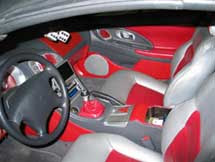


Follow these instructions to achieve a professional show quality interior.
Step 1 - Cleaning and Removal of Panels
The first step to take is to remove all the pieces you would like painted. On areas you cant remove from the car such as the dashboard it is extremely important to mask off the entire area around where you are painting. It is also important to leave all the doors open so that a good airflow will stop a cloud of paint from forming on the interior of the car. It will also help speed up the drying time. Once you have all pieces masked the next step is to clean each piece rigorously. It is very important that you do not leave any grease or debris on the panels that are about to be painted, otherwise the debris will be embedded underneath the paint.
Step 2 - Sanding and Contouring of Panels
The second step to take is contouring or sanding the pieces about to be painted. Depending on the finish you would like to achieve this step may be bypassed. Personally we usually like to have a nice smooth surface finish on most of our interior pieces. To achieve this you must start with a semi course sandpaper such as 800 grit. Make sure than when you are sanding each individual piece you do so evenly. Once you have removed the majority of bumps and indents in the plastic panels the next step is to move onto a finer grade paper. We suggest at least 1000 grit paper. Simply complete the same as was done with the 800 grit paper and move on to finishing sandpaper to complete the process.
This step should not be overlooked as the primer will help point out any mistakes you have made with the sanding. It will also help the actual base paint adhere better to the finish. Simply hold the primer can about 8 inches away from the surface to be painted and begin spraying in slightly overlapping strokes. Once you have applied a thin coat let each piece fully dry. This should take anywhere between 10 minutes and 30 minutes depending on he thickness of coating you have applied. Once the piece have fully dried check for any areas that appear to be uneven. If it is necessary continue to sand these areas with finishing sandpaper and repeat the priming step
Step 4 - Applying the Base Coat
Once you are completely satisfied with the finish of your primed pieces the next step is to apply the base coat. Try to purchase automotive exterior paint form your local auto supply store. This paint tends to work the best for painting car pieces. Its best to stay away from universal type spray paints. Once you are ready begin the painting process by applying several light coats. Wait at least 15 minutes between coats for best results. Its always better to apply several thin coats than a couple of thick coats. Once you have finished the base coat the next process is to let the pieces dry overnight so that they can properly cure.
Step 5 - Applying the Clear Coat
The second last step to take in painting your panels is to apply a good quality automotive clear coat to each of the pieces. The stage should not be overlooked as it will provide a super smooth and tough finish to each of your painted pieces. Once you have applied several coats of clear coat it may take several days before the pieces are properly cured. It is very important not to rush the drying process. The longer you let your pieces dry the better finish you will probably achieve.
Step 6 - Rubbing Compound and Finishing Wax

0 komentar: